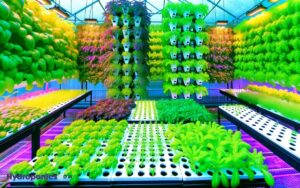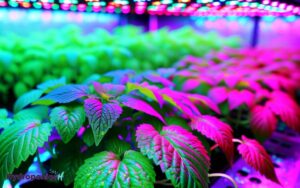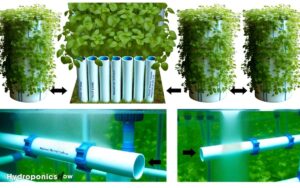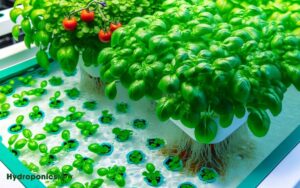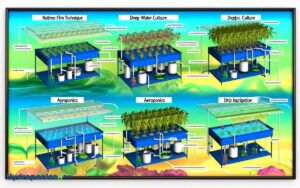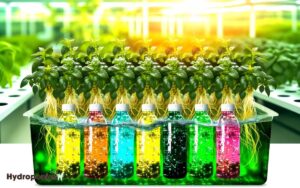Top Choices for 2024: Best Type Hydroponic Systems
Selecting the best hydroponic system depends on growth objectives and resource availability. Deep Water Culture (DWC) offers simplicity and consistent oxygenation.
Nutrient Film Technique (NFT) enables efficient nutrient utilization but requires constant monitoring. Aeroponics excels in delivering oxygen but demands advanced management.
Ebb and Flow systems are versatile yet require precise timing. Drip Systems are scalable but may necessitate frequent maintenance.
The Kratky Method is cost-effective but less adaptable for large-scale operations. Integrated systems like Aquaponics introduce symbiotic benefits, while Vertical Hydroponics maximize spatial efficiency.
Hybrid systems combine multiple techniques for optimized performance. Understanding these nuances reveals deeper insights.
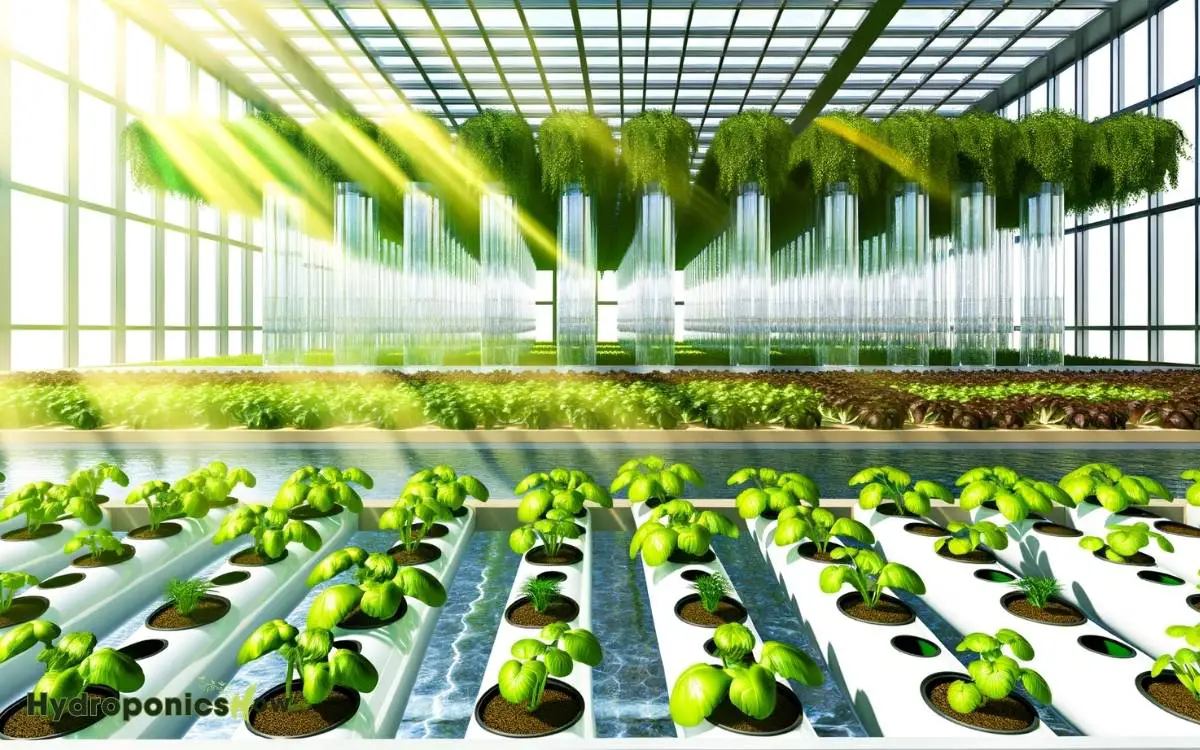
Key Takeaways
Deep Water Culture (DWC)
Deep Water Culture (DWC) is a hydroponic method in which plant roots are submerged directly in a nutrient-rich, oxygenated water solution, facilitating ideal nutrient uptake and growth.
This system utilizes air pumps to continuously oxygenate the water, ensuring roots receive adequate dissolved oxygen, essential for cellular respiration and metabolic processes.
The constant availability of nutrients and oxygen promotes accelerated growth rates and higher yields.
DWC systems are typically employed using net pots that suspend plants above large reservoirs of nutrient solution. This configuration minimizes the risk of root diseases and allows for precise control over pH and nutrient levels.
DWC is advantageous for growing fast-growing, water-loving plants such as lettuce, basil, and cannabis, providing a highly efficient hydroponic solution.
Nutrient Film Technique (NFT)
Nutrient Film Technique (NFT) operates by continuously circulating a thin film of nutrient solution over the roots of plants, which are supported by a slightly sloped channel.
This method offers several advantages, including efficient nutrient delivery and minimal water usage, making it particularly suitable for fast-growing, lightweight crops such as lettuce and herbs.
Understanding the operational mechanics, benefits, and ideal plant types for NFT can greatly enhance hydroponic productivity and sustainability.
How NFT Works
The Nutrient Film Technique (NFT) operates by continuously circulating a shallow stream of nutrient-rich solution over the roots of plants, ensuring peak oxygenation and nutrient uptake.
This method involves the use of sloped channels, usually made of PVC, where a thin film of nutrient solution flows.
The solution is pumped from a reservoir to the higher end of the channel, allowing gravity to facilitate its flow back to the reservoir.
This continuous circulation prevents stagnation and promotes nutrient absorption. The film’s thinness is critical, as it exposes the root zone to ample oxygen, reducing the risk of root diseases.
Precision in maintaining the correct slope and flow rate is essential for the most favorable plant growth, making NFT a highly efficient hydroponic technique.
Advantages of NFT
One of the primary advantages of the Nutrient Film Technique (NFT) is its ability to provide optimal oxygenation to plant roots, greatly enhancing growth rates and overall plant health.
The continuous, thin film of nutrient solution guarantees that roots receive a consistent supply of oxygen, nutrients, and water. This method minimizes the stagnation of nutrient solution, which can lead to root diseases.
Additionally, the efficient nutrient delivery system reduces water and nutrient waste, making NFT highly sustainable. The absence of growing medium in NFT systems also simplifies root monitoring and management, allowing for early detection of potential issues.
The design of NFT systems facilitates easy scalability, making them suitable for both small-scale and commercial hydroponic operations.
Best Plants for NFT
Selecting the most suitable plants for the Nutrient Film Technique (NFT) requires an understanding of the specific growth characteristics and nutrient needs of various crops.
Leafy greens such as lettuce, spinach, and kale thrive in NFT systems due to their shallow root structures and rapid growth rates, which align well with the constant nutrient flow.
Herbs like basil, mint, and cilantro also perform exceptionally, benefiting from the consistent nutrient delivery and oxygenation.
Additionally, strawberries can adapt to NFT setups, provided they receive adequate support and temperature control.
It’s essential to avoid larger, fruiting plants like tomatoes or cucumbers, as their extensive root systems can clog channels, disrupting nutrient flow and leading to suboptimal growth conditions.
Aeroponics
Aeroponics represents an advanced hydroponic system where plant roots are suspended in air and intermittently misted with nutrient-rich water solution, greatly enhancing nutrient delivery efficiency. This method not only maximizes oxygen exposure to the roots but also reduces water consumption compared to traditional soil-based cultivation. To further optimize growth, growers often incorporate the best air diffusers for hydroponics, ensuring a consistent supply of oxygen to the nutrient solution. As a result, plants in an aeroponic system tend to grow faster and healthier, making it a preferred choice for sustainable and high-yield farming.
This method guarantees excellent oxygenation, thereby promoting superior root health and minimizing the risk of root diseases.
The precise control over nutrient application in aeroponics leads to accelerated plant growth and higher yields compared to traditional soil-based cultivation systems.
Plant Root Health
Ensuring optimal plant root health in aeroponic systems necessitates a thorough understanding of root physiology and the precise delivery of nutrient-rich mist to the root zone.
The absence of a growth medium means roots are suspended in air, optimizing oxygen availability, which is vital for effective cellular respiration and nutrient uptake.
However, this setup demands meticulous control of environmental parameters such as humidity, temperature, and misting intervals to prevent desiccation or hypoxia.
Additionally, pathogen control is imperative; the high humidity environment can foster microbial growth, necessitating rigorous sterilization protocols.
Regular monitoring and adjustments ensure roots receive adequate aeration and hydration, promoting robust growth and maximizing yield potential. Properly maintained aeroponic systems can thus achieve superior plant health and productivity.
Nutrient Delivery Efficiency
Effective nutrient delivery in aeroponic systems hinges on the precise formulation and timing of nutrient-rich mist application to guarantee maximum absorption by plant roots. This efficiency is paramount for optimizing plant growth and health.
Key factors include:
- Nutrient Solution Composition: Formulating a balanced mix of macronutrients and micronutrients is essential.
- Mist Frequency and Duration: Proper programming of mist intervals ensures roots receive adequate nutrients without waterlogging.
- Droplet Size: Fine mist droplets improve nutrient uptake by increasing the surface area of root contact.
- System Maintenance: Regular cleaning and monitoring prevent nozzle clogging, ensuring consistent mist delivery.
Understanding and controlling these parameters secure that aeroponic systems deliver nutrients with high precision, thereby enhancing plant development and yield.
Ebb and Flow
Ebb and Flow systems, also known as flood and drain systems, utilize a submersible pump to periodically flood the grow tray with nutrient solution, subsequently allowing it to drain back into the reservoir.
This cyclical process guarantees excellent oxygenation of the root zone, promoting vigorous plant growth.
The system’s design minimizes nutrient waste and facilitates efficient uptake by plant roots. By adjusting the flooding frequency and duration, growers can tailor the nutrient delivery to specific plant needs.
However, the system is not without challenges; pump failure or timer malfunction can lead to root desiccation or oversaturation. Proper maintenance and monitoring are essential to mitigate these risks.
Drip Systems
In contrast to the periodic flooding mechanisms of Ebb and Flow systems, Drip Systems provide a continuous and controlled delivery of nutrient solution directly to the base of each plant, ensuring a consistent supply of essential nutrients and ideal moisture levels.
This method offers several advantages:
- Ideal: Nutrient delivery can be finely tuned to meet the specific needs of different plant species.
- Effectively: Minimizes water and nutrient waste by targeting the root zone directly.
- Scalability: Easily adapted for both small-scale and commercial operations.
- Reduced Disease Risk: By avoiding standing water, the risk of root-related diseases is greatly diminished.
These characteristics make Drip Systems a top choice for growers seeking to maximize yield and resource efficiency.
Wick Systems
Wick systems represent one of the most straightforward hydroponic configurations, relying on capillary action for nutrient delivery. This passive mechanism eliminates the need for pumps, reducing mechanical complexity and energy consumption.
The simplicity of setup and maintenance makes wick systems particularly suitable for small-scale or beginner hydroponic applications.
Simple Setup Process
A wick system, one of the simplest hydroponic setups, relies on capillary action to deliver nutrient solution from a reservoir to the plant roots. The simplicity of its setup process makes it accessible for beginners and cost-effective for small-scale operations.
To establish a wick system, follow these steps:
- Select a Reservoir: Choose a container to hold the nutrient solution, ensuring it is non-reactive and appropriately sized for your plants.
- Position the Wicks: Install absorbent wicks, such as nylon or cotton, that extend from the nutrient solution to the growing medium.
- Prepare the Growing Medium: Use a medium with high capillary action, like perlite or coco coir, to optimize nutrient uptake.
- Planting: Position the plants in the growing medium, ensuring roots are in contact with the wicks.
This method’s straightforward nature promotes ease of maintenance and scalability.
Passive Nutrient Delivery
The wick system operates on the principle of passive nutrient delivery, where the capillary action of wick materials guarantees a constant supply of nutrient solution to the plant roots without the need for active pumping mechanisms.
Typically, materials such as nylon or cotton are employed as wicks due to their high absorptive properties.
This system is exceptionally advantageous for small-scale or low-maintenance hydroponic setups. The simplicity of its design reduces mechanical failure risks and energy consumption.
However, it is important to monitor the wick’s efficiency, as clogging or degradation can impede nutrient flow. Additionally, this system is less effective for larger plants with higher nutrient demands, making it ideal for smaller, less nutrient-intensive crops.
Kratky Method
Renowned for its simplicity and efficiency, the Kratky Method offers a passive hydroponic technique that eliminates the need for pumps and continuous water circulation.
This method leverages the natural uptake of nutrients by plants, utilizing a static reservoir that gradually depletes as plants grow.
Key advantages include:
- Minimal Maintenance: Requires infrequent monitoring and no mechanical components, reducing potential points of failure.
- Cost-Effectiveness: Absence of pumps and timers lowers initial setup and ongoing operational costs.
- Scalability: Easily adaptable from small-scale home systems to larger commercial operations.
- Energy Efficiency: No electricity required for water movement, making it ideal for off-grid applications.
The Kratky Method’s straightforward design and operational ease make it an attractive option for both novice and experienced hydroponic gardeners.
Aquaponics
Building upon the principles of hydroponics, aquaponics integrates fish farming with plant cultivation, creating a symbiotic system where fish waste provides organic nutrients for plants, and plants naturally filter the water for fish.
This closed-loop system enhances resource efficiency by reducing the need for synthetic fertilizers and minimizing water usage through recirculation.
Nitrogenous compounds, primarily ammonia from fish excreta, are biologically converted by nitrifying bacteria into nitrates, which are then absorbed by plants.
This dual-production model not only augments plant growth rates but also guarantees healthier fish populations due to improved water quality.
Key components include a fish tank, biofilter, grow beds, and a sump tank, all designed to maintain ideal conditions for both aquatic and plant life, ensuring maximum productivity.
Vertical Hydroponics
Vertical hydroponics maximizes space utilization by stacking multiple layers of plant cultivation systems, enabling high-density growth in confined areas. This approach maximizes yield per square meter and is particularly advantageous for urban farming or indoor gardening.
Key benefits of vertical hydroponics include:
- Space Efficiency: Vertical arrangements allow for a significant increase in the number of plants grown per unit area.
- Resource Conservation: Enhanced water and nutrient use efficiency due to a recirculating system reduces waste.
- Controlled Environment: Facilitates precise control over environmental parameters, such as light, temperature, and humidity, promoting excellent plant growth.
- Reduced Pests and Diseases: Minimizes the spread of soil-borne diseases and pests, contributing to healthier crops.
Hybrid Systems
Hybrid hydroponic systems combine elements of multiple hydroponic techniques to optimize resource use, enhance plant growth, and address specific cultivation challenges.
By integrating methodologies such as Nutrient Film Technique (NFT) and Deep Water Culture (DWC), hybrid systems leverage the strengths of each approach.
For instance, NFT offers efficient nutrient delivery and oxygenation, while DWC guarantees consistent hydration and root support. This amalgamation can result in superior yields, improved nutrient uptake, and greater resilience against system failures.
Additionally, hybrid systems can be tailored to specific crop requirements, facilitating versatile and customizable cultivation environments.
Such systems often employ advanced sensors and automated controls to monitor and adjust pH, nutrient concentration, and environmental conditions, thereby maximizing efficiency and productivity.
Conclusion
In evaluating the efficacy of different hydroponic systems, Deep Water Culture offers simplicity and robustness, whereas Nutrient Film Technique provides efficient nutrient delivery.
Aeroponics maximizes oxygenation, contrasting with the intermittent flooding of Ebb and Flow.
Drip Systems guarantee precise nutrient control, juxtaposed against the passive nature of the Kratky Method.
Aquaponics merges aquaculture with hydroponics, while Vertical Hydroponics optimizes space.
Hybrid Systems integrate multiple approaches, highlighting the dynamic interplay and potential synergies within hydroponic cultivation.
The choice of system ultimately hinges on specific cultivation goals and resource availability.

